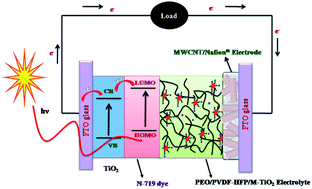Improved electrochemical and photovoltaic performance of dye sensitized solar cells based on PEO/PVDF–HFP/silane modified TiO2 electrolytes and MWCNT/Nafion® counter electrode†
Abstract
A polymer blend electrolyte membrane was prepared for dye sensitized solar cells (DSSCs) based on poly ethylene oxide (PEO) and poly (vinylidene fluoride-co-hexaflouropropylene) (PVDF–HFP) filled with surface modified titanium dioxide (M-TiO2) nanofillers. The surface of TiO2 was modified using aminopropyltrimethoxysilane. The electrochemical studies indicated that the addition of surface modified nanoparticles increased the ionic conductivity up to 7.21 × 10−4 S cm−1 for 7 wt%, whereas the ionic conductivity was about 8.14 × 10−5 S cm−1 with the addition of an unmodified counterpart as the filler into the PEO/PVDF–HFP blend system. In addition to this ionic mobility, charge carrier concentration and ion diffusion coefficient were also increased with the addition of surface modified TiO2 nanoparticles. Wide angle X-ray diffraction (WAXD) results showed the reduction in the crystalline phase of PEO/PVDF–HFP blend electrolyte with the addition of M-TiO2. The influence of TiO2 surface functionality on the degree of crystallinity of the polymer matrix was analyzed using differential scanning calorimetry (DSC). Thermo mechanical behavior of the composite membranes was studied by dynamic mechanical analysis (DMA). The thermo gravimetric analysis (TGA) investigations of membranes indicated that the thermal degradation temperatures of hybrid nanocomposites were enhanced upon the addition of nanosized inorganic fillers. The morphological characterizations were carried out by atomic force microscopy (AFM). The solid state dye sensitized solar cell has been fabricated by using a silane modified TiO2/PEO/PVDF–HFP polymer nanocomposites electrolyte, and multiwalled carbon nanotube (MWCNT)/Nafion® as the counter electrode. The photovoltaic characteristics of constructed cells showed an enhancement of open circuit voltage (Voc) from 0.62 to 0.71 V and the best efficiency achieved was about 2.84%. The enhancement of the DSSC was further confirmed by electrochemical impedance spectroscopy (EIS) studies for lowest Warburg resistance (Rdiff).


 Please wait while we load your content...
Please wait while we load your content...